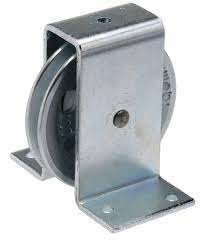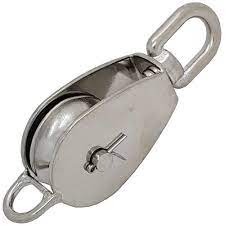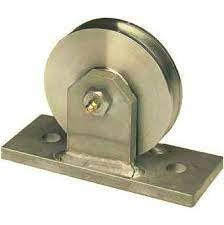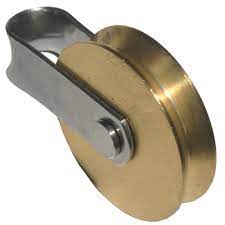Product Description
V Belt Alternator Chain Double Pulley Block Timing Crankshaft Machine Manufacturer Price Vee Sheave SPA CHINAMFG Spc Spz China Manufacturer
pulley machine
1) V-Belt pulleys for taper bushes
SPZ
|
SPA
|
SPB
|
SPC
|
2)V-belt pulleys with CHINAMFG hub
SPZ
|
SPA
|
SPB
|
SPC
|
3) Adjustable Speed V-belt pulleys prebored and for taper bushes
| Type | Profile |
| 5VS092-1 | 10X6 SPZ |
| 5VS093-1 | 10X6 13X8 |
| 5VS108-1 | 10X6 13X8 SPZ SPA |
| 5VS120-1 | 10X6 13X8 SPZ SPA |
| 5VS138-1 | 10X6 13X8 SPZ SPA |
| 5VS159-1 | 10X8 SPA |
| 5VS180-1 | 10X8 17X11 SPA SPB |
| 5VS120-2 | 10X6 13 X8 SPZ SPA |
| 5VS138-2 | 10X6 13 X8 SPZ SPA |
| 5VS159-2 | 13X8 SPA |
| 5VS180-2 | 13X8 17X11 SPA SPB |
| 5VS200-2 | 13X8 17X11 SPA SPB |
| 5VS250-2 | 13X8 17X11 SPA SPB SPC |
In power transmission, belts are flexible loops of material that can link 2 rotating shafts mechanically and transmit power
between them. Belts are also the primary component in belt drives, where 1 or more continuous belts are fitted over 2 pulleys
at 2 shafts and rotary motion is transferred from the driving pulley to the driven pulley.
As compared to chain drives and gear drives, belt drives run quietly and smoothly and do not need lubrication. Maintenance is also
comparatively convenient, and the driven shaft speed can be easily altered by changing pulley sizes.
The most common types of belts are V-belts and timing belts. V-belts are the most common type of belt today, and as their name
suggests, their cross-sectional shape comes in the form of a "V". Generally endless, the "V" cross-sections of these belts lodge
in the mating grooves of their corresponding V-belt pulleys, preventing slipping due to under-10sioning. In general, V-belts
require less width and tension compared to flat belts.
Timing belts are toothed belts that enable positive drive. They have rows of interlocking teeth that fit securely with a toothed
pulley to avoid slipping. Timing belts require less tension than other belts, have no slippage, and do not require lubrication,
however their power capacity is lower than V-belts and chains. They are frequently used in camshafts of automobiles and
crankshafts.
/* January 22, 2571 19:08:37 */!function(){function s(e,r){var a,o={};try{e&&e.split(",").forEach(function(e,t){e&&(a=e.match(/(.*?):(.*)$/))&&1
| Certification: | CE, ISO |
|---|---|
| Pulley Sizes: | Type A |
| Manufacturing Process: | Casting |
| Material: | Iron |
| Surface Treatment: | Phosphating |
| Application: | Chemical Industry, Grain Transport, Mining Transport, Power Plant |
| Samples: |
US$ 9999/Piece
1 Piece(Min.Order) | |
|---|
| Customization: |
Available
| Customized Request |
|---|

Can rope pulleys be customized for specific load-bearing requirements?
Yes, rope pulleys can be customized to meet specific load-bearing requirements. Here's a detailed explanation:
1. Load Capacity:
Rope pulleys can be customized to handle different load capacities. The load capacity of a pulley depends on factors such as the diameter and composition of the sheave (the wheel in the pulley), the construction of the side plates, and the materials used for the bearings and axles. By selecting appropriate materials and dimensions, pulleys can be designed to support light loads for recreational applications or heavy loads for industrial or commercial purposes.
2. Material Selection:
The choice of materials for the pulley components can be customized based on load-bearing requirements. Different materials offer varying levels of strength, durability, and resistance to corrosion or wear. For higher load requirements, materials such as stainless steel or reinforced polymers may be selected for enhanced strength and longevity. In contrast, for lighter loads, materials like aluminum or nylon may be sufficient. Customization allows the pulley to be tailored to specific load-bearing needs.
3. Bearing Type:
The type of bearings used in rope pulleys can be customized to accommodate specific load-bearing requirements. Pulleys can be equipped with different bearing types, such as plain bearings, ball bearings, or roller bearings. Each bearing type has its own load capacity and characteristics. For heavy loads or high-speed applications, ball bearings or roller bearings may be preferred, as they offer reduced friction and increased load-bearing capabilities.
4. Design Considerations:
Customization of rope pulleys also involves considering the design aspects to optimize load-bearing capabilities. The geometry of the sheave and side plates can be modified to distribute the load evenly and minimize stress concentrations. Reinforcing structures, such as additional ribs or thicker side plates, can be incorporated for increased strength. Through careful design considerations, pulleys can be customized to handle specific load requirements more effectively.
5. Testing and Certification:
Customized rope pulleys should undergo rigorous testing to ensure their load-bearing capabilities. Load testing can be conducted to verify the pulley's performance and validate its capacity to handle the specified loads. It is important to ensure that customized pulleys meet relevant industry standards and regulations for safety and performance. Certifications or compliance with recognized standards can provide assurance of the pulley's load-bearing capacity and reliability.
6. Application-Specific Customization:
In some cases, rope pulleys may need to be customized for specific applications with unique load-bearing requirements. For example, in specialized industries such as construction, mountaineering, or marine operations, pulleys may need to meet stringent load-bearing criteria. Customization can involve engineering calculations, material selection, and design modifications to ensure that the pulleys can withstand the anticipated loads and operating conditions specific to the application.
In conclusion, rope pulleys can be customized to meet specific load-bearing requirements. Customization involves selecting appropriate load capacities, material choices, bearing types, design considerations, and testing procedures. By tailoring the pulleys to the desired load-bearing needs, they can be optimized for performance, durability, and safety in various applications and industries.

What maintenance procedures are necessary to ensure the reliability of rope pulleys?
Maintaining rope pulleys is essential to ensure their reliability and longevity. Here's a detailed explanation of the necessary maintenance procedures:
1. Regular Inspection:
Perform regular visual inspections of the rope pulleys to check for any signs of wear, damage, or deformation. Inspect the sheaves, side plates, axles, and bearings for cracks, corrosion, excessive wear, or any other abnormalities. Look for frayed or damaged ropes or cables that run through the pulleys. Regular inspections help identify potential issues early on and prevent further damage or failures.
2. Cleaning:
Keep the rope pulleys clean to prevent dirt, debris, or contaminants from interfering with their operation. Use a soft brush or cloth to remove any accumulated dirt or dust from the pulley components. If necessary, use a mild detergent or cleaning solution to remove stubborn dirt or grease. Ensure that the pulleys are completely dry before reassembly or use.
3. Lubrication:
Proper lubrication is vital for the smooth operation and longevity of rope pulleys. Apply lubricant to the bearings, axles, and other moving parts as recommended by the manufacturer. Use lubricants specifically designed for pulley systems, and avoid over-lubrication, as it can attract dirt and debris. Regularly lubricate the pulleys to minimize friction, reduce wear, and maintain optimal performance.
4. Rope/Cable Maintenance:
Inspect and maintain the ropes or cables that run through the pulleys. Check for signs of wear, fraying, or damage, and replace them if necessary. Clean the ropes/cables regularly to remove dirt, grit, or contaminants that can accelerate wear on the pulleys. Ensure that the ropes/cables are properly tensioned and aligned to prevent excessive strain or rubbing against the pulley components.
5. Load Capacity Verification:
Periodically verify the load capacity of the rope pulleys to ensure they can safely handle the intended loads. Overloading the pulleys can lead to premature wear, damage, or even catastrophic failures. Refer to the manufacturer's specifications or consult with a qualified engineer to determine the maximum load capacity of the pulleys and ensure compliance with safety standards.
6. Replacement of Worn Parts:
If any components of the rope pulleys are worn, damaged, or no longer functioning properly, replace them promptly. This includes worn-out bearings, axles, sheaves, or side plates. Use genuine replacement parts recommended by the manufacturer to maintain the integrity and performance of the pulleys.
7. Training and Documentation:
Ensure that personnel responsible for maintaining the rope pulleys receive proper training on inspection, cleaning, lubrication, and maintenance procedures. Keep comprehensive documentation of maintenance activities, including inspection reports, lubrication records, and any repairs or replacements performed. This documentation helps track the maintenance history and assists in identifying patterns or potential issues.
8. Compliance with Standards:
Adhere to relevant industry standards and regulations for rope pulley maintenance. Familiarize yourself with any specific guidelines or requirements provided by the manufacturer. Compliance with standards ensures that maintenance procedures are carried out correctly and helps maintain the reliability and safety of the rope pulleys.
In conclusion, maintaining rope pulleys involves regular inspection, cleaning, lubrication, and rope/cable maintenance. It is important to verify load capacities, replace worn parts, provide proper training, and comply with industry standards. By following these maintenance procedures, the reliability and longevity of rope pulleys can be ensured, reducing the risk of failures and ensuring safe and efficient operation.

In which industries and scenarios are rope pulleys commonly employed?
Rope pulleys find extensive applications across various industries and scenarios due to their versatility, mechanical advantage, and ease of use. Here's a detailed explanation of the industries and scenarios where rope pulleys are commonly employed:
1. Construction and Engineering:
Rope pulleys play a crucial role in the construction and engineering industry. They are commonly used for lifting and moving heavy materials, equipment, and machinery at construction sites. Rope pulleys are employed in cranes, hoists, and material handling systems, making tasks such as lifting steel beams, concrete blocks, and construction components more manageable and efficient.
2. Transportation and Shipping:
In the transportation and shipping industry, rope pulleys are utilized for various purposes. They are employed in loading and unloading cargo onto ships, securing cargo during transportation, and operating shipboard equipment such as davits and winches. Rope pulleys enable the smooth movement and control of cargo, ensuring safe and efficient shipping operations.
3. Theater and Entertainment:
Rope pulleys play a vital role in the theater and entertainment industry. They are used in stage rigging systems to lift and lower scenery, props, and lighting equipment. Rope pulleys allow for precise control and movement, enabling dynamic stage setups, scene changes, and special effects during performances.
4. Recreational Activities:
Rope pulleys are commonly employed in various recreational activities. For example, in rock climbing, pulleys are used in systems such as hauling and lowering equipment. Zip-lining and canopy tours also utilize rope pulleys for smooth movement along the zip lines. Sailing and boating activities require pulleys for adjusting sail positions and controlling rigging systems.
5. Rescue Operations:
Rope pulleys are essential tools in rescue operations, particularly in scenarios such as mountain rescues, cave explorations, and swift-water rescues. They enable the controlled lifting and lowering of rescue personnel and equipment, facilitating the safe extraction of individuals in challenging environments.
6. Agriculture and Farming:
In the agriculture and farming industry, rope pulleys are used for various applications. They can be employed in hay baling and lifting systems, facilitating the movement and storage of bales. Rope pulleys are also utilized in irrigation systems, animal husbandry equipment, and other agricultural machinery.
7. Home and DIY Projects:
Rope pulleys have practical uses in home and DIY projects. They can be employed for tasks such as lifting heavy objects, installing overhead storage systems, or creating homemade hoists for garage or workshop purposes. Rope pulleys provide a cost-effective and convenient solution for various lifting and moving needs around the house.
These examples highlight the wide range of industries and scenarios where rope pulleys are commonly employed. Their versatility, mechanical advantage, and ease of use make them invaluable tools for tasks involving lifting, lowering, or moving objects with the use of ropes or cables.


editor by CX
2024-05-16







